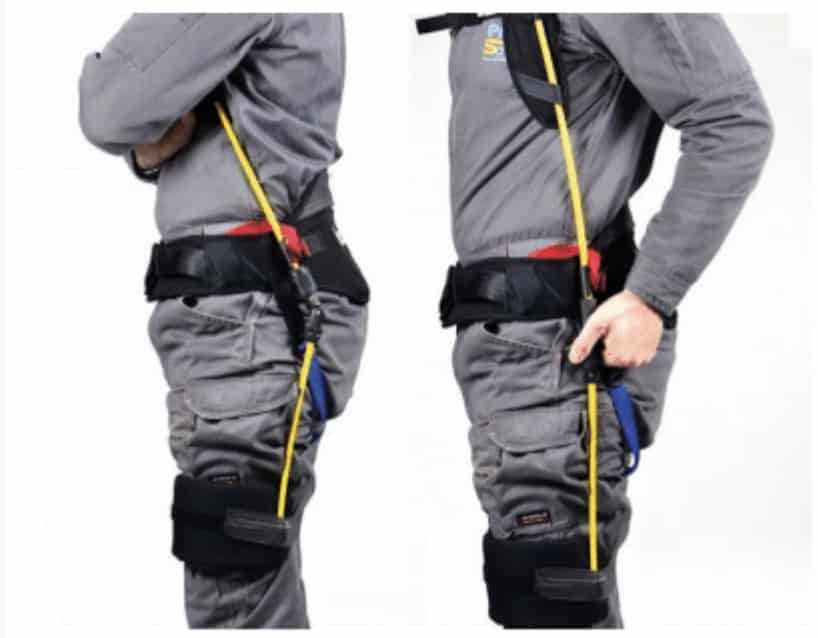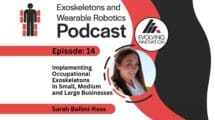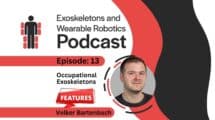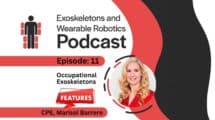For years we have heard how using wearable exoskeletons can have desirable secondary effects. Now, a team from Construction Health and Safety New Zealand (CHASNZ) has published the results of a small study on roofers in a short webinar that shows just that. The study followed three roofers (n=3) in New Zealand for a total of two weeks as they worked and went home to rest. For one week, the roofers used a passive back support exoskeleton, and one week without to serve as a baseline. The CHASNZ team used wearable sensors to record and compare the recovery of the three workers between shifts. You can register and view the results of the study in a webinar format for free at the CHASNZ website: Link.
Suppose you are familiar with medical or occupational (industrial) exoskeletons. In that case, you may have run across claims that the devices can have a positive effect beyond their intended use case when appropriately worn and used in the right conditions. For medical exoskeletons that support walking physical rehabilitation, the initial positive output would be numerous consistent steps taken by the patient, with fewer professionals needed to initiate ambulation. Secondary effects could be better circulation or increased urinary bladder health. Similarly, occupational exoskeletons aim to reduce injury rates and, in some cases, improve the quality of work. They also aim to minimize strain and fatigue on workers so they can go home feeling better, have more energy, and be better prepared for the next workday. But measuring these desired “secondary” effects is difficult since most exo technology studies occur in a lab and usually last less than an hour.
CHASNZ is a “charitable trust developed in 2018 with the objective of improving the lives of construction workers by raising the standard of health and safety culture and performance across the construction industry in New Zealand.” Together with the Roofing Association of New Zealand (RANZ), and exo distributor Exxovantage, the organization performed a pilot trial to answer these more elusive questions. The next goal is to repeat the study with more participants and analyze if the rest and sleep gains with exoskeletons are reproducible.
The webinar shows that the trial was based on specific positions that roofers assumed during the day that strained the back. The exoskeleton was selected specifically to help with positions where roofers are bending excessively forward in the “stooped” position and are producing a significant moment arm on their back (the position represents a significant risk for MSD).
Unfortunately, this is a very small study, and the next round that is planned isn’t much larger. However, it is good to see data on the desirable secondary effects of exoskeletons. Studies like this can make calculating the return on investment (ROI) of exo technology significantly easier.
The webinar panel includes the following:
- Chris Polaczuk (CHASNZ)
- Dr. Kelly Dale (Healthy Lifestyle NZ)
- Arnaud Daurat (Exxovantage)
- Paul Stanley-Boden (Red & Black Roofing Co)
Interjection: it is unusual for an exo technology webinar to include a direct user of the technology. It is a pleasant surprise.
Outline of the webinar:
- 0 – 4 minutes introduction
- 4 – 9 minutes overview of the trial
- 9 – 19 minutes overview of the HAPO passive back-assist exoskeleton used
- 19 – 37 minutes results of the trial
- 37 – 44 minutes user perspective
- 44 – 52 minutes next steps and Q&A
The pilot study is also presented in writing and is accessible through the CHASNZ website. One aspect that the written report emphasizes where the webinar did not is the importance of prior education before the exoskeleton is introduced. For example, how to push through a “tough guy” image who doesn’t need injury prevention aids of any kind. Another one is rebuking that the risk of injury and wear and tear on the body is an “inevitable” part of the job.
Both the webinar and written report are lighter and easier to digest than a standard research paper:









Add Comment